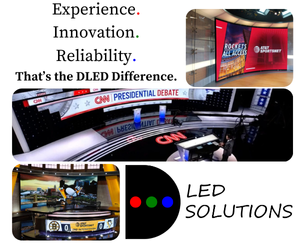Industry Insights: The future of audio mixing and broadcast audio systems

Subscribe to NCS for the latest news, project case studies and product announcements in broadcast technology, creative design and engineering delivered to your inbox.
In this first installment of this two-part Industry Insights roundtable, we explore the latest developments in broadcast audio technology.
Industry experts weigh in on innovations shaping the field, from wireless multichannel audio systems to IP-based workflows. The discussion covers advancements in mixing tools, the impact of automation, and the challenges of implementing new technologies. Our panelists also address the evolving landscape of audio compression and microphone technology.
This roundtable examines how broadcasters leverage cutting-edge audio solutions to enhance production quality and efficiency.
Key takeaways from the Industry Insights roundtable
- Wireless Multi-channel Audio Systems (WMAS) are emerging as a significant advancement in broadcast audio, offering more efficient use of RF spectrum.
- IP-based workflows, particularly ST 2110, are gaining popularity in broadcast facilities, driving demand for AES67-compatible audio solutions.
- Virtualization and cloud-based technologies are enabling more flexible and efficient audio processing and distribution in broadcast environments.
- While automated mixing tools offer benefits, experts emphasize the continued importance of human monitoring and intervention in audio production.
- Advanced audio technologies, such as immersive audio and personalization, are enhancing storytelling capabilities, but their application must be content-appropriate.
What are the latest innovations in broadcast audio technology?
Tobias von Allwörden, manager, broadcast and film, Sennheiser: Wireless multichannel audio systems (WMAS) will be the next big thing in broadcast productions. These systems use digital wideband technology and will offer bi-directional bodypacks as well as make more efficient use of the available RF spectrum, to name just a few advantages.
Chris Phillips, technical applications engineering, Sennheiser: ST 2110 workflows have gained popularity for their ability to deliver high-quality audio and video streams over IP networks, offering flexibility and efficiency to broadcast operations. With an increasing number of broadcast facilities transitioning towards ST 2110, the demand for audio solutions compatible with the AES67 standard is rising. In response to this industry shift, audio manufacturers have introduced a variety of new AES67 product solutions to the market.
Larry Schindel, senior product manager, Telos Alliance: One innovation broadcasters can now take advantage of is the ability to transmit audio as a bed mix with separate dialogs all the way to the viewer, allowing them to select which dialog(s) they want to hear in the presentation they listen to. Not only does this allow all viewers to receive the full multichannel experience, it also saves the broadcaster critical bandwidth by not having to deliver multiple complete mixes. Serial ADM is a new industry-standard method that enables the metadata necessary for this type of personalized experience to be delivered from production all the way through the broadcast chain to the final transmission encoders.
Chris Scheck, head of marketing content, Lawo: Audio-over-IP and virtualization are no doubt the most important evolutionary steps. A growing number of stations and production service providers try to “shrink” their equipment pool, which turns open-standards IP into a desirable network solution. Processing apps running on generic CPUs, or CPUs and GPUs, provide broadcasters with more agility as the same compute hardware can be used for a variety of processing tasks at different times of the day.
How are new audio mixing tools and techniques enhancing the creative possibilities for broadcast sound design?
Tobias von Allwörden: These new tools offer ease of use and self-configuration, with products in general having become more flexible and also forgiving when not properly used or placed. This not only ensures good results, even for novice users or non-experts, but also frees capacity for creative experimentation.
Chris Phillips: More consumers than ever have ways to experience immersive audio; however, most consumers are still listening on stereo speakers or headphones. Content providers have used advancements like Ambeo spatial audio to unlock investments in immersive content for everyone still on stereo by processing existing immersive mixes to create an improved 2-channel audio experience. This rendering can now also be done in real-time for live events, meaning the broadcast can create an immersive multichannel mix and still deliver an improvement to those listening with stereo.
Chris Scheck: Surgical level corrections, sonic tweaks as well as fast changes still require a hardware mixing console, yet well-designed GUIs running on a tablet or a touchscreen can be more convenient for scripted productions. Our KICK software has been used for top-tier sports productions in Europe for over a decade. AI is certainly a hot topic, and most vendors are working on it, but we have yet to see how this will pan out.
Dee McVicker, marketing director, Wheatstone: We have gotten pretty good at putting it all on a touchscreen that is similar in layout to how they’re used to accessing all those controls and features on a fixed mixing desk. And we can network all that through AoIP to another surface or via IP to a server, cloud or another facility entirely. Broadcasters no longer have to concentrate on how or where we need the right tool. In that respect, they’re freer to create today than they’ve ever been.
How are broadcasters leveraging advanced audio technology?
Henry Goodman, director of product management, Calrec: Since the pandemic, broadcasters have adopted a variety of audio technologies to work more efficiently and to deliver more content across a more diverse range of channels, and manufacturers like Calrec have quickly adapted their product ranges to meet these needs. The biggest shift has been the widespread adoption of remote and distributed working, allowing a sound engineer to mix an event from an acoustically treated studio on the other side of the world with fully redundant connectivity. Broadcasters are now making moves into pure cloud-native DSP processing in environments like AWS, and the ability to spin up additional DSP whenever it is required is a huge move away from traditional broadcast audio architectures.
Larry Schindel: Broadcasters are taking advantage of infrastructure that’s being virtualized and distributed. For example, our Infinity and VIP systems are “matrix-less” broadcast intercom systems with signaling, mixing, and processing distributed across devices without a centralized matrix. This functionality has also been shifted to virtual instances which can run either on-premises or in the cloud.
Dee McVicker: We have been putting fully functional mixing consoles behind touchscreens and on tablets for some time. But in the last year or so, we’re seeing a lot more application for virtual mixers because they’re easier to take to the ballfield, for example, and they easily integrated with production systems so they can serve as an extension of the studio.
What are the technical challenges in implementing advanced audio technologies in broadcast productions?
Tobias von Allwörden: For hardware, the challenges are usually the form factor (small size) and power consumption of portable systems, while for software, it’s the easy integration (UI/UX) of complex systems into existing workflows.
Chris Phillips: As we see facilities navigate the transition to ST-2110 IP based workflows, the drastic change going from traditional routers to managing and operating distribution over networks can be challenging. Our goal as a manufacturer is to be involved in supporting these projects and meeting the evolving needs of broadcasters and content creators.
Henry Goodman: As more broadcasters look to embrace the benefits of IP, the biggest technical challenges are historic; many broadcasters already have SDI infrastructures which are doing a good job and the majority have neither the budget nor the motivation to build a new IP infrastructure from the ground up. Most are moving to IP slowly, implementing hybrid systems which use IP gateways and bridges to make the shift. It is especially important for all broadcast manufacturers to be on the same page and ensure compliance with both network standards like ST 2110 and 2022-7 as well as AMWA recommendations like NMOS IS-04 and IS-05 for NMOS stream discovery and connection management.
Larry Schindel: One of the biggest challenges is latency. Migrating from baseband (SDI, AES3, MADI, etc.) to an IP-based workflow involves increased latency. Shift that up to the cloud, and there’s even more latency. The latency of the media transport itself is one thing, but the latency the operator experiences when adjusting controls is an even more critical issue to solve.
Dee McVicker: The challenge for us as an audio over IP manufacturer is how to take advantage of some of the new advancements in enterprise technology, like server and cloud, so that it truly benefits our customers. As an industry we have unique needs in realtime delivery of AoIP that enterprises don’t have. We recognized that cloud and servers can reduce cost and overhead, which is why we developed the Layers Software Suite line. But foremost, these additions to the broadcast production chain need to be applicable, reliable and durable. I think we’re doing a pretty good job of balancing all that.
What are the potential drawbacks or limitations of relying heavily on automated audio mixing systems?
Henry Goodman: Automated mixing tools are nothing new; the Dugan Automix, which was a collaboration between Dan Dugan and Calrec’s sister company Sound Devices, dates back to the mid-1970s! Automated mixing apps can automate a lot of the heavy lifting to give a sound mixer the scope to finesse other parts of their mix. Live sports broadcasters, for example, adopt many more mic sources to better capture the crowd as well as the on-field action, and with broadcasters expected to deliver a greater variety of output formats, manufacturers like Calrec provide a range of built-in assistive software apps like automated up and downmixing which help take the pressure off the sound engineer riding the faders. But monitoring all those outputs is still crucial, and that is still essential to do so using a real pair of non-automated, analogue ears!
Chris Scheck: While recovering from a glitch in the event of a failure may take time, the number of drawbacks and limitations is surprisingly small. Lightning-fast and high-quality automation routines are usually programmed by an experienced sound supervisor and can then be monitored by an assistant. Quite a few of our clients leverage advanced automation, in combination with robotic cameras for news and morning shows.
How can broadcasters ensure that the use of advanced audio technologies enhances, rather than distracts from, the storytelling?
Henry Goodman: Next Generation Audio (NGA) is the umbrella term that the audio industry has adopted to describe a raft of technologies which are designed to enhance storytelling, from immersive audio to audio personalization. Calrec consoles have enough processing and dedicated control surface architecture to mix the biggest Dolby Atmos immersive presentations, but none of it enhances storytelling if it is not sympathetic to the content; for live sports, an immersive mix can place viewers directly into the emotional centre of the crowd, but for something like live news the opposite is true, creating a disconnect and drawing focus away from the subject. With 3D soundbars and binauralized headphone downmixes delivering readily available immersive content, consumers have easy access to this content, but broadcasters must retain control of when it is — or isn’t — appropriate.
Dee McVicker: If it’s easy to use, there’s a pretty good chance it’s going to be useful — for storytelling, in particular. That’s really the litmus test for any product.
What are the most significant advancements in microphone technology for broadcasting in recent years?
Chris Phillips: The issue of spectrum over-saturation has been a persistent problem in the telecommunications industry, leading to limited bandwidth availability and network congestion. This past February, the FCC approved major changes to allow for Wireless Multi-channel Audio Systems (WMAS), a groundbreaking decision that is set to revolutionize the market. This gives manufacturers the green light to develop advanced systems where multiple wireless microphones, IFBs, or IEMs can use the same carrier for better efficiency in the wireless spectrum.
What role does audio compression play in maintaining sound quality in broadcasting across various platforms?
Tobias von Allwörden: With everything becoming digital, even the quality of compressed audio has reached a point where it has become almost impossible to hear any loss of quality.
Larry Schindel: Modern audio codecs achieve a higher compression ratio (lower data rate) while maintaining the same quality level as older codecs. Still, it’s important to remember that each time an audio signal is compressed, information that (in theory) you can’t hear is simply discarded. Keeping content in the uncompressed/PCM domain until the final transmission, minimizing the number of transcodes, and keeping data rates a bit higher all help to preserve the audio quality of the content when it reaches the viewer.
Dee McVicker: High speed links are becoming more available but we’ll still need audio compression for those many remaining links that aren’t. We have good audio compression algorithms today that sound decent and we also have transport standards like RIST, which adjusts in real-time to achieve the lowest latency and fastest performance for a given link, whether it’s to an AWS data center far away or a concert venue across town. We’ll need both of those tools today for live streaming and moving media across the public internet, which is why we include RIST and audio codecs in our I/O units (Blades) that make up our AoIP system.
Subscribe to NCS for the latest news, project case studies and product announcements in broadcast technology, creative design and engineering delivered to your inbox.






tags
AES67, Chris Phillips, Chris Scheck, Dee McVicker, Henry Goodman, Larry Schindel, Lawo, Sennheiser, serial ADM, SMPTE ST 2110, spatial audio, Telos Alliance, Tobias von Allwörden, Wheatstone
categories
Audio Mixing & Audio Consoles, Broadcast Engineering, Broadcast Equipment, Encoders, Heroes, Industry Insights, Voices